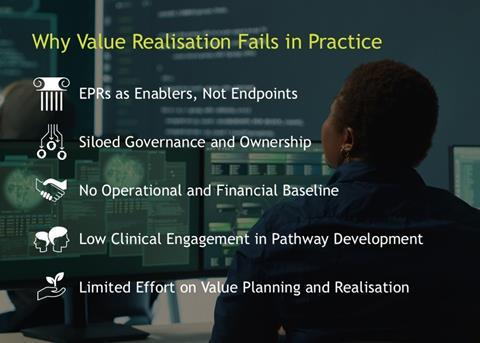Despite major investments, most EPRs fall short on outcomes, writes BCG. To unlock their full potential, the NHS should shift its focus from technical implementation milestones to value delivery.
Why do so many EPRs fail to deliver the promised outcomes?
Despite billions spent amid widespread adoption, many healthcare leaders find that going live with an electronic patient record fails to translate to real-world improvement. Systems may be deployed “on time and on budget”, but the intended benefits – safer care, smoother operations, better patient and staff experiences – fail to materialise.
Sponsored and written by
This challenge is not unique to healthcare. Analysis shows that 20–25 per cent of large-scale IT projects across industries deliver no return on investment 1. However, according to BCG’s Digital Acceleration Index, healthcare ranks among the least mature industries in digital capability, where many systems still focus on rolling out features rather than delivering impact. One pitfall we frequently observe is defining EPR “success” purely by meeting installation timelines, rather than the value generated for patients and clinicians 2.
Healthcare providers need to flip the EPR paradigm. Adopting a value-first mindset means redefining success as better patient safety, more efficient care pathways, improved staff satisfaction, and demonstrable impact on outcomes, not merely EPR feature completion.
For example, instead of configuring EPR systems primarily around existing clinical preferences or replicating paper-based workflows, leading institutions redesign workflows based on optimal patient journeys.
Here we explore why the traditional approach continues to fall short, but how a genuinely value-driven model can unlock the potential of EPR investment. In our experience, the most common and impactful sources of value in EPR programmes fall into a few repeatable areas: reducing medication errors through decision support and closed-loop prescribing; improving patient flow via better discharge planning and real-time bed management; streamlining clinical documentation to save staff time; and enabling proactive care through more structured data capture and analytics.
These focus areas not only improve care quality and safety but also deliver measurable operational and financial returns, making them ideal starting points for value-first delivery.
The status quo: EPRs deliver systems, not outcomes
Working with healthcare organisations, we often observe that EPR initiatives over-index on delivering technology, rather than tangible clinical and operational outcomes. Business cases are typically long lists of intended benefits, but once delivery begins, the focus shifts to technical milestones. Meanwhile, the actual value that was promised – improved care quality, operational efficiency, and better patient outcomes – is often deprioritised.
This is rarely due to lack of intent. Instead, it’s driven by several systemic issues:
- No empowered value realisation stream: Many programmes lack a dedicated, high-authority function with the teeth to lead value delivery. Instead, benefit tracking becomes a passive reporting exercise.
- Lack of 80/20 focus: Once a business case is written, all benefits often carry equal weight. But not all features deliver equal value. Programmes should identify and focus on the 20 per cent of capabilities that deliver 80 per cent of outcomes.
- Static value assumptions: Programmes often fail to revisit and adapt their definition of value as implementation progresses. Yet in multiyear initiatives, what matters in year one may not be what matters in year three.
- Overreliance on EPR as the sole enabler: True value is often delivered through EPR plus complementary capabilities, workflow redesigns, analytics platforms, and change management efforts, which are frequently out of scope.
As a result, even when technical delivery is flawless, outcomes often fall short. In fact, nearly half of clinicians in one study reported that their electronic health record reduced their clinical effectiveness 1. In one US hospital, clinicians reported spending significantly more time on documentation after the new EPR went live – roughly two hours of extra electronic paperwork for every hour of patient care 3. Instead of streamlining workflows, the EPR frustrated staff rather than adding value. In too many cases, there is no upfront design for value realisation, and programmes fail to define how each priority outcome will be measured and course-corrected during implementation.
The UK Healthcare Financial Management Association has highlighted systemic shortfalls in how benefits are managed: weak use of non-financial indicators, poor post-implementation evaluation, and limited accountability. But these failures often stem from inadequate programme design. Without structured benefits planning and ownership baked into delivery governance, value becomes an afterthought.
A value-led approach starts with planning. It includes articulating outcomes, designing workflows that support them, assigning clinical and operational leadership, and setting mechanisms for active intervention when progress stalls. To truly realise benefits, organisations must treat value as an operational deliverable, not a retrospective report.
Why value realisation fails in practice
What consistently goes wrong in EPR initiatives that they technically succeed but practically underdeliver?

Recurrent failure modes include:
- EPRs as enablers, not endpoints: A fundamental oversight is treating the EPR as the destination, rather than the foundation. Based on BCG’s experience, the EPR should be seen not as the solution itself, but as a digital foundation of a broader digital change management programme. True transformation value is only unlocked by pairing EPR systems with wider organisational capabilities, like redesigned workflows, analytics, and operational models.
- Siloed governance and ownership: IT teams are typically tasked with delivering the system, while clinical and operational leaders are expected to deliver outcomes. Without unified sponsorship and shared ownership from day one, programmes fail to achieve meaningful patient and staff benefits.
- No operational and financial baseline: Many organisations launch EPR programmes without establishing a clear baseline of current-state performance. Without measuring key metrics, there is no way to prove value post-implementation.
- Minimal clinical engagement: When frontline clinicians are only superficially involved in design and deployment, the system rarely aligns with real-world workflows. Clinician involvement in leadership roles is essential, not optional.
- Weak value planning and prioritisation: Without a dynamic approach to value management, there’s no adaptation as circumstances evolve. Programmes fail to prioritise the high-impact 20 per cent of functionality that delivers 80 per cent of the outcomes, instead becoming weighed down by full-scope delivery.
The consequences of these missteps are evident in industry research and high-profile projects. For example, a physician survey by the American Medical Association found more than half of respondents reported their EHR had a negative impact on cost, productivity, or efficiency in their practice 1. Similarly, the US Veterans Affairs’ $16bn EHR modernisation has become a cautionary tale: despite massive investment, early rollout sites were plagued by poor workflow design and user dissatisfaction, and the VA’s inspector general linked several patient safety events to EHR-related issues 4. A 2022 analysis noted that the expected benefits of digitising health records “have not yet materialised” in terms of improved cost or quality of care 3.
Conclusion: Reimagine EPRs as value engines
It’s time to reimagine EPRs not as technology upgrades, but as platforms for transformation. When designed and delivered through a value-first lens, EPRs become enablers of system-wide improvement, from safer, more consistent clinical care to more agile operations, better patient journeys, and empowered staff.
Used effectively, EPRs can reduce avoidable harm, unlock actionable data, and accelerate care delivery. Realising this potential requires leadership to anchor every decision, from initial planning through post-go-live optimisation, in the question: “How will this drive measurable value?”
For leaders embarking on or in the midst of an EPR journey, the imperative is clear: demand more than software. Treat EPRs as foundational infrastructure for better care, not endpoints in themselves. With the right focus and governance, they can be the catalyst not only for digital maturity, but for lasting organisational change.
With thanks to: Thomas Jefferies; Chengshi Luo; William Prager; Chris Young; Cassandra Yong; and Stephen Sutherland
References:
1 Green J. (2024). 10 EHR failure statistics: Why you need to get it right first time. EHR in Practice. Available from: https://www.ehrinpractice.com/ehr-failure-statistics.html
2 Becker M, Grebe M, Kim ZG, Gehder M, Leyh M.(2020). How Digital Divides Health Care Providers. Boston Consulting Group. Available from: https://web-assets.bcg.com/5d/78/9248b7cf40978670f2ef343b1dbd/bcg-how-digital-divides-health-care-providers-dec-2020.pdf
3 Colicchio TK, Cimino JJ, Del Fiol G. (2019). Unintended consequences of nationwide electronic health record adoption: challenges and opportunities in the post-Meaningful Use Era. J Med Internet. Res. 2019;21(6):e13313. Available from: https://pmc.ncbi.nlm.nih.gov/articles/PMC6682280/
4 Dashevsky J. (2025) Why the VA’s $16B EHR Modernization Is Still Falling Short. Healthcare Huddle. Available from: https://www.healthcarehuddle.com/p/why-the-va-s-16b-ehr-modernization-is-still-falling-short

University hospitals key to unlocking UK’s £78bn healthcare innovation potential
Unlocking the power of end-to-end digital solutions in healthcare: Global insights for the NHS
Climbing blind up the productivity mountain: how transparency, equity and trust could deliver care for 10-15 million more patients
































